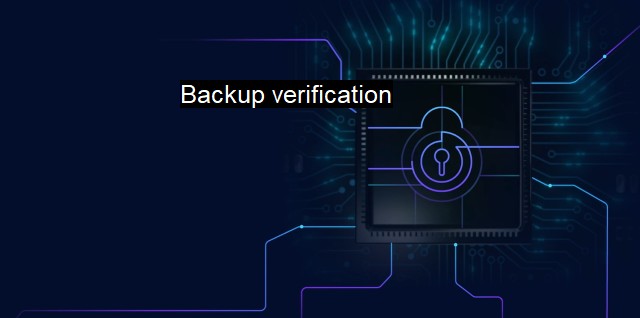What is Backup verification?
The Importance of Backup Verification for Data Backups and Cybersecurity: Protecting Your Business from Cyber Attacks and Breaches
Backup verification is a vital protocol an integral part of data protection and recovery. It's the process of confirming that a backup system creates an accurate duplication of data and ensures that the data can be accurately restored if needed. Typically, backup verification involves validating the data thoroughly to ensure that it's true to its original form and capable of being restored successfully.Data backup is an essential part of any organization's security and antivirus program. Its primary role is to restore operational continuity following a security breach affecting the data integrity of an organization. Computer viruses, ransomware, or unauthorized access can compromise an organization's data, leading to substantial disruption of its operations. Thus, the right antivirus program combined with an appropriate data backup strategy offers the frontline defense against such threats.
Executing backups itself is not enough. It's equally crucial to ensure that what is being saved is trustworthy, uncorrupted, and can be restored exactly as it is. Enter backup verification - its purpose is to validate the credibility and integrity of the backup copies.
The first layer in backup verification checks whether the data backup operation was successful or not. This approach involves validating the completion status of the backup operation, error scanning, and comparing the size of the backup file with the original data. A successful operation means the data has been copied, but it reflects little about the fidelity of the backup to the primary data.
The next layer of backup verification entails more thorough checking, such as reading the backup data to verify if it aligns with the original. Some backup systems even deploy checksum and hash algorithms to complement this. Checksum verification involves generating a checksum value before the backup operation that would later be compared with the checksum value after the backup operation. A matching value corroborates that the data has not been manipulated during the backup operation.
Meanwhile, hash verification services use unique identity markers for data, comparing the markers of the original data and the copied data. If the identities match, it denotes credibility of the backup as the data wasn't altered or corroded during the backup process.
The most rigorous backup verification approach is the restoration test, where a full restore operation is executed from the backup data. If the system works seamlessly with the restored data, it implies that the backup's data integrity was maintained. This type of thorough checking guarantees the effectiveness of a backup, though it can be quite resource-intensive.
Backup verification draws paramount importance. Cyber attackers are evolving with sophisticated techniques, and unverified backups can act as Trojan horses, hiding malware or compromised files within the backup. This makes it essential to validate backups for not just data fidelity but also for security robustness. Antivirus programs play a crucial part here, by routinely scanning the backup data to reveal any hidden threats or anomalies.
Through regular backup verification, organizations can protect themselves from possible loss of important data due to corruption, hardware failure, or cyberattacks. Ignoring the importance of backup verification could cost a company severely in terms of both financial losses and damaged reputation. Regular backup coupled with thorough verification thus becomes the cornerstone of a successful cybersecurity strategy. backup verification is no longer optional but a fundamental way to ensure data safety and operational continuity in the digital era.

Backup verification FAQs
What is backup verification?
Backup verification is the process of ensuring that a backup file of data is complete, accurate, and usable. It involves checking the integrity of the backup file by comparing it to the original data to ensure that it is an exact copy.Why is backup verification important in cybersecurity and antivirus?
Backup verification is essential in cybersecurity and antivirus because it ensures that your data is protected and can be recovered in case of an attack or system failure. Without backup verification, there is a risk that your data backups may be incomplete or corrupted, and you may not be able to recover your data when you need it most.How is backup verification done?
Backup verification can be done manually or through automated tools. The manual process involves comparing the backup file to the original data and checking for any discrepancies. The automated process involves using software that verifies the integrity of the backup file by comparing its checksum or hash value to the original data.How often should backup verification be performed?
Backup verification should be performed regularly, preferably after every backup operation. This ensures that your backup files are always up-to-date and that you can recover your data when you need it. In addition, backup verification should be performed whenever there is a significant change in the data or system configuration, such as after a software upgrade or hardware replacement.| | A | | | B | | | C | | | D | | | E | | | F | | | G | | | H | | | I | | | J | | | K | | | L | | | M | |
| | N | | | O | | | P | | | Q | | | R | | | S | | | T | | | U | | | V | | | W | | | X | | | Y | | | Z | |
| | 1 | | | 2 | | | 3 | | | 4 | | | 7 | | | 8 | | |||||||